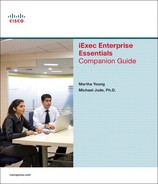You have successfully completed the Business Essentials Program!
As this course concludes the discussion on the business fundamentals necessary for building and maintaining a web-enabled business, it is a good idea to briefly review the concepts that have been covered.
Module 1, “Strategic Imperatives,” introduced global trends, opportunities, and strategic imperatives driving the use of the Internet and IT. As you saw, Internet-enabled IT, first widely deployed during the dot-com bubble, has now entered the mainstream of business. Those businesses that adopt such technology and the applications enabled by it will find that they have a significant edge in the marketplace. The benefits that Internet-enabled IT confers on any organization are considerable. Not only businesses, but organizations of all types are moving to deploy applications that allow better integration with suppliers, customers, and even competitors.
Module 2, “Management Strategies,” explained IT-enabled business strategies and the evolution to the networked virtual organization (NVO). As you saw, this process depends on understanding the core functions that define your organization. These are generally those functions that allow you to improve your intellectual property assets or that provide a competitive edge in delivering value to your customers.
Module 3, “Organizational Readiness,” explored how to assess and build organizational readiness and how to improve IT governance. It also discussed the importance of organizational readiness to improving business outcomes. The module included several toolkits that can help you build IT governance, such as concepts associated with budget management and control.
Module 4, “ICT Solutions,” examined Internet-enabled solutions and internal and external business processes. This module also discussed the delivery of value and the value chain. Value chains involve operation processes and supporting processes, many of which can be effectively improved through the application of information and communications technology (ICT). Some of the processes that can be improved include workforce optimization, finance, and human resources (HR) functions.
Module 5, “Strategy Development,” assessed the process of situational analysis and visioning success. In this module, you discovered the power of building a business strategy that defines how a business will interact with the market and the forces that control that market. You saw how a situation analysis, when done in a structured way, will yield important intelligence on ways to successfully engage with competitors and customers to achieve success.
Module 6, “Portfolio Management,” described the project management and change management processes, including the portfolio management approach, and how they can be used to create a successful Internet-enabled business roadmap. In this module, you also discovered how the effective management of IT projects can deliver transforming IT solutions to the organization in an incremental way that reduces risk and ensures a positive return to the business.
Module 7, “Business Case,” helped you apply some basic financial concepts and calculations for the creation of a business case.
This course should enhance your knowledge of the opportunities, tools, and approaches required to plan and implement better strategies.
Through the strategic use of the Internet and IT, you should be able to create an actionable proposal and business justification for an Internet-enabled business application that will provide measurable benefits to your organization.
Having completed this program, you should now be able to do the following:
Identify global trends and the impact of the Internet and information technology (IT) on businesses.
Describe how the Internet and IT can be used to address the challenges and opportunities facing your business.
Assess your organizational readiness, and describe the importance of leadership, governance, competencies, and technology to your success.
Examine your organization’s situation, key challenges, and needs, and create an e-vision for success.
Identify and prioritize opportunities for process improvement using the Internet and IT.
Recognize the importance of portfolio management and change management to the success of your Internet and IT initiatives.
Build a business case for an improvement project involving Internet-enabled solutions that can deliver measurable benefits to your organization.
Of course, any one of these modules could fill libraries. In fact, new books are being released every day that address each of the topics reviewed in this course in exhaustive depth. The good news is that you now have all the fundamentals you need to successfully build a web-enabled business. At its core, business is still about having a good idea and then successfully translating that idea into revenue by using it to satisfy an unmet need in the market. The technology just helps you do it better, faster, and with a better chance of success.
Think of this course as a primer on how to ask questions. If you see an area where technology could make an improvement, it is likely that you will seek expert assistance. Armed with the principles laid out in this course, you should be able to articulate your technology needs, suggest some alternatives, and then intelligently evaluate the answers you get.
The main concept central to this material is that truly transformational technology is available, and the processes and structures necessary to apply it are easy to understand and relatively easy to apply. As you seek to utilize ICT solutions to transform your organization, keep in mind that others have successfully done so. If you need it, help is available.
Good luck!
